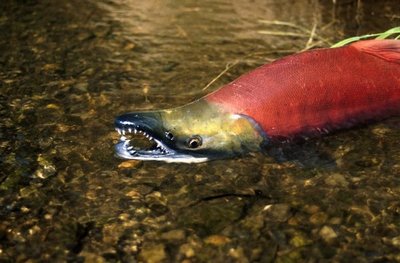May 9, 2003
Solid management, natural resilience both key to sockeye success
The resilience of sockeye salmon runs in Alaska’s Bristol Bay -– after a century of fishing they’re as healthy as they’ve ever been – is about strength in numbers.
It’s not just an abundance of fish, although the numbers returning to spawn is tens of millions more than the total across the lower 48 states and prudent actions by fishermen and the Alaska Department of Fish and Game have helped make it a classic example of a sustainable fishery.
As it turns out, it’s also about having a large number of population segments, or components, the fish in each programmed to breed and thrive under conditions somewhat different from the fish in other components, University of Washington researchers report in this week’s Proceedings of the National Academy of Sciences.
It’s an important natural buffer in the face of changing environmental conditions, particularly those affected by climate, that can make winners out of seemingly insignificant components of the population, or stock, while dwarfing the once mighty.
Salmon managers in the Pacific Northwest and elsewhere, as well as those overseeing other fish and shellfish populations, need to consider this biocomplexity within a species, say the UW’s Ray Hilborn, Thomas P. Quinn and Donald Rogers, all professors of aquatic and fishery sciences, and Daniel Schindler, associate professor of biology. The loss of biocomplexity is a characteristic of salmon in the Pacific Northwest, where many stock components were lost because of dams or deliberate overharvesting in an attempt to maximize catch from hatcheries, the authors say.
It’s why protecting only the habitat and fish of today’s strongest runs is a mistake. One can’t know for sure which runs might “stumble” in the future, Quinn says.
Sockeye is one of four species of salmon found on the West Coast and in Alaska. It is most different from the other species because the young spend a year, sometimes more, in freshwater lakes before heading to sea. Alaska’s Bristol Bay sockeye has traditionally been the most valuable salmon fishery in the world, at its height worth $200 million to $400 million and, with today’s prices, worth between $30 million and $50 million.
In work funded by the National Science Foundation, the Bristol Bay salmon processors and the University of Washington, the scientists looked at the shifting fortunes of the salmon in the three Bristol Bay fishing districts, each with its distinct network of rivers and lakes. Through the 1950s, ’60s and mid ’70s, when conditions tended to be cooler and drier because of the influence of the Pacific Decadal Oscillation, the Naknek and Kvichak network far exceeded the other two districts. The dominant contribution was from Lake Iliamna, the United State’s largest lake behind the Great Lakes.
In 1977-78 the Pacific Decadal Oscillation switched to a different phase leading to warmer and wetter conditions with higher water levels and flows among the results. The productivity of the three fishing districts began shifting in response, Hilborn says.
Today Lake Iliamna contributes so few fish that it requires special protective management. The Egegik network, which feeds another of the fishing districts studied and which earlier accounted for a mere 5 percent of the catch, expanded greatly until the ’90s when the third fishing district, the Nushagak, increased. In some recent years, the Nushagak has been the most important fishery in Bristol Bay.
“In the 1950s, managers could have chosen to overlook the Egegik or Nushagak systems, and at the time the cost would have appeared to be low,” the authors write.
The Bristol Bay sockeye stock is an amalgamation of several hundred discreet populations, or components. It’s all those local adaptations that stabilize the system, Quinn says. The advantage goes to deeper-bodied males when fighting for places to spawn and attracting females, until one considers what happens when streams run lower than usual. Then those deeper-bodied males are more likely to become stranded and, because they stick up higher out of the water, are easier for hungry bears to bite than males in the components of the stock that have average, or even smaller-than-average, body depths.
Egg size, preferred spawning sites, the size of young when hatched are among the many other adaptations that could give advantages depending on conditions.
“We buy insurance for the future by having networks of habitat and not just trying to save the habitat of today’s strongest runs,” Schindler says. This might necessitate a much finer scale of management than is the current norm, the co-authors say.
###
For more information: Hilborn, (206) 543-3587, rayh@u.washington.edu; Quinn, (206) 543-9042, tquinn@u.washington.edu; Schindler, (206) 616-6724, deschind@u.washington.edu
For a copy of the article: Jill Locantore, PNAS, 202-334-1310, jlocantore@nas.edu
Images for use by news media only. Photo credit: U. of Washington/Thomas Quinn
Sockeye returning to spawn develop flame-red bodies and vivid green heads with pronounced teeth and hooked snouts.
http://www.washington.edu/newsroom/news/images/sockeye-salmon.jpg
http://www.washington.edu/newsroom/news/images/sockeye-stream.jpg



